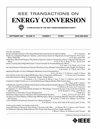机电时间尺度下随网DFIG-WT与成网变换器的暂态稳定性分析
IF 5.4
2区 工程技术
Q2 ENERGY & FUELS
引用次数: 0
摘要
由于暂态控制开关的存在,双馈感应发电机风力发电机组(GFL-DFIG)的机电动态将受到激励,并与基于电网形成的电压源变换器(gfl - vsc)产生显著的相互作用。在电力电子化的过程中,会产生新的机电同步问题。机电相耦合特性反映了不平衡有功功率与设备内电压相位之间的关系,对理解同步过程至关重要。本文揭示了GFL-DFIG和ggm - vsc之间的非线性机电耦合,并分析了两者之间的暂态同步稳定性。首先,从不平衡励磁和内部电压响应的角度提出了分析模型。然后,采用“柔性耦合”的概念定量分析了虚转子位置与相对内电压相位之间的机电耦合特性。最后,分析了GFL-DFIG与ggm - vsc之间的瞬态同步机制,建立了新的瞬态不稳定约束。讨论了失同步现象和关键因素的影响原理。本文章由计算机程序翻译,如有差异,请以英文原文为准。
Transient Stability Analysis Between Grid-Following DFIG-WT and Grid-Forming Converter in Electromechanical Timescale
Due to the transient control switch, the electromechanical dynamic of grid-following-based doubly fed induction generator-based wind turbine (GFL-DFIG) would be excited and significantly interact with grid-forming-based voltage-source converter (GFM-VSC). So that new electromechanical synchronous issues would occur in the becoming power-electronized system. The coupling characteristic between mechanical and electrical phases, which reflects the relationship between unbalance active power and internal voltage phase of apparatus, is crucial for understanding the synchronous process. This paper reveals the nonlinear mechanical-electrical coupling and analyzes the transient synchronous stability between GFL-DFIG and GFM-VSC. Firstly, the analytical model is proposed from the perspective of unbalanced power excitation and internal voltage response. Then, the mechanical-electrical coupling characteristic between virtual rotor position and relative internal voltage phase is quantitatively analyzed by employing concept of ‘flexible coupling’. Finally, the transient synchronization mechanism between GFL-DFIG and GFM-VSC is analyzed and a novel transient instability constraint is found. The loss-of-synchronization phenomenon and influence principles of key factors are also discussed.
求助全文
通过发布文献求助,成功后即可免费获取论文全文。
去求助
来源期刊

IEEE Transactions on Energy Conversion
工程技术-工程:电子与电气
CiteScore
11.10
自引率
10.20%
发文量
230
审稿时长
4.2 months
期刊介绍:
The IEEE Transactions on Energy Conversion includes in its venue the research, development, design, application, construction, installation, operation, analysis and control of electric power generating and energy storage equipment (along with conventional, cogeneration, nuclear, distributed or renewable sources, central station and grid connection). The scope also includes electromechanical energy conversion, electric machinery, devices, systems and facilities for the safe, reliable, and economic generation and utilization of electrical energy for general industrial, commercial, public, and domestic consumption of electrical energy.
 求助内容:
求助内容: 应助结果提醒方式:
应助结果提醒方式:


